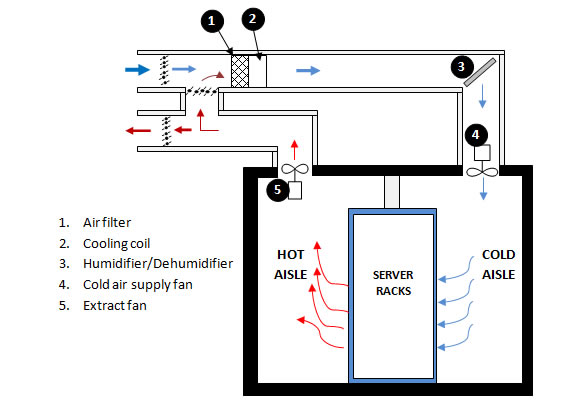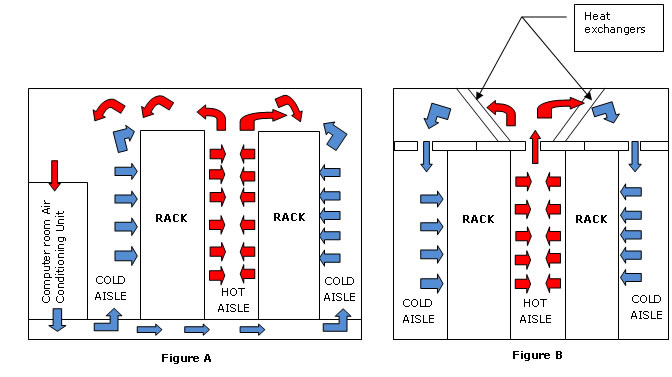Data Centres and Renewable Energy Project


Approaches to data centre cooling and air conditioning
Unlike in buildings, data centre environments must be designed and maintained within tight bands of ASHRAE requirements for temperature and relative humidity. This is to avoid any failures and prevent any thermal shutdowns caused by loss of cooling (1).
Information technology improvements towards faster servers to meet the growing demand for internet services have resulted in higher heat dissipating servers, creating more challenges in cooling. Various strategies to meet increasing heat dissipations challenges in data centres have also been implemented.
This page presents some of the cooling and air conditioning strategies in data centres.
Hot aisle and cold aisle containment
The hot-aisle/cold aisle (2) technique was invented by Dr. Robert F. Sullivan while working at IBM in 1992 (3). As shown in the figure below, the backs of two opposite rows of racks form the hot aisle (red arrows) while the fronts of two opposite rows of racks form the cold aisle (blue arrows).
The cold aisle provides cold air directly to the front of all the racks and hence to the servers while the hot aisle receives the warm air discharged by the servers after completing its cooling purpose.
At this point, we would like to coin two phrases to describe the way the hot aisle/cold aisles containment technique is used.
- Basic hot aisle/cold aisle containment (Figure A)
- Enhance hot aisle/cold aisle containment (Figure B)
Basic hot aisle/cold aisle containment (Figure A)
Here the racks are arranged on a raised floor.
Hot aisle air is drawn through the cooling equipment or an air handling unit, cooled and supplied to the cold aisle through the space below the raised floor creating a positive pressure in the that space.
Openings are provided on the raised floor section in the cold aisle allowing cold air to reach the front of the racks. Small fans installed in servers then pull the cold air across the hot electronic components from where it gains heat and is discharged into the hot aisle. The cycle continues as this hot air is drawn again by the air handling equipment from the data centre space.
Although Figure A demonstrates a good step in air flow management, a few issues are associated with that approach.
- Hot air can easily mix with the cold air in the cold aisle which affects the efficiency of the cooling equipment
- Servers in the top region of the racks would typically lack enough cold air at the desired temperature due to unintended hot and cold aisle air mixing.
- Hot spots develop in areas where cooling is not sufficient within the rack which can shorten the life of servers and cause thermal shutdowns or server failures.
- This is an inefficient arrangement as the cooling system has to move and cool a lot of air.
Enhance hot aisle/cold aisle containment (Figure B)
In this case, there is no raise floor and the hot and cold aisle are physically separated from each other. This prevents any hot and cold aisle air mixing.
This time, cold water heat exchangers are installed overhead. Blowers or fans are provided to suck air from the hot aisle across the heat exchangers and damp for cooling.
The cold air is then damped into the front of the servers in the cold aisle. It is then drawn across the servers by cooling fans to accomplish the cooling and discharged into the hot aisle. As the servers need constant cooling the cycle continues.
This design has gained momentum and has currently found prominence in containerised data centres permitting high density racks in a cargo container (4).
Adsorption and Absorption Chilling
Data centres connected to the grid have to pay extra money in carbon taxes due to the fact that the largest percentage of grid electricity is generated from polluting fossil fuel plants.
In these circumstances it would be a good idea to consider alternative power supply options that would generate some or all the electricity needed to power the data centre.
Combined heat and power (CHP) technologies have started gaining momentum in this regard. For data centres the waste heat from the power solution can be used in either adsorption or absorption chillers systems to provide for the IT cooling load.
The production of power, heat and cooling using a combination of various technologies is known as tri-generation or combined, cooling, heating and power (CCHP).
Depending on the data centre user requirements, heat storage facilities need should be considered.
Further approaches to data centre cooling
Increasing energy efficiency requirements and data centre power density have motivated further improvements and research focusing on improving air flow management, microprocessor level cooling systems; data centre environment control systems, in-rack cooling using intercoolers and “free cooling”.
Our proposed cooling design layout
Because the climate in northern Scotland is largely cold thought the year, it is possible to employ the “free cooling” concept to save on the energy costs that would be incurred through using chillers.
To ensure high cooling efficiencies and smart air flow management, the hot aisle and cold aisle containment would be appropriate. The drawing below depicts the cooling and air flow management system we would recommend.

Precise control of supply air temperature and moisture content is paramount to ensure longevity of the IT equipment.
Because outside ambient air can contain undesirable impurities, air filters are provided in the supply duct to trap all particulates. Due to changing climatic conditions, there are times when some humidification and dehumidification as well as cooling will be needed.
Hot air recirculation when it is too cold outside eliminates the need for a heating element in the supply duct.
Controllers set to monitor conditions in the supply duct as well as in the cold aisle and hot aisle and on rack surfaces determine suitable system operation limits. Variable speed fans for cold aisle air supply and hot aisle air extraction are controlled by the same control system.
Ambient air temperature and moisture content varies frequently throughout the year. A robust control system can however condition these variations. A consolidated control system would pretty much be a building management system (BMS) for monitoring and reacting to data centre space conditions.
Dealing with dust and gases
Dust is a real issue if talking about air-side economisers i.e. bringing ambient air into the data centre. However, filtrations technologies are currently mature to handle it.
However, combustion gases or any other gases in the atmosphere can also pose a threat to the life of the IT equipment inside the data centre. This however is an area for further investigation to establish the impact different gases in the atmosphere can have on Information Technology.
References used in this page:
(1) Ramadhon, R. et al. (2009) Optimization of Cooling Systems in Data Centre by Computational Fluid Dynamics Model and Simulation. In: Proceedings of Innovative Technologies in intelligent systems and industrial applications, Monash University, Sunway Campus, Malaysia, 25 to 26 Jul 2009, accessed 9 April 2010, http://ieeexplore.ieee.org/stamp/stamp.jsp?arnumber=05224189
(2) Blumling, J. & Lewis, S. (2009) Webinar Playback: Data Center Containment Solutions, 42U, Available from: http://www.42u.com/webinars/Aisle-Containment-Webinar/playback.htm, Accessed 15 April 2010.
(3) Robert F. S. (2002) Alternating Cold and Hot Aisles Provides More Reliable Cooling for Server Farms. Uptime Institute, accessed 03/05/2010, http://www.dataclean.com/pdf/AlternColdnew.pdf
(4) Hamilton, J. (2006) An Architecture for Modular Data Centers. Microsoft Corporation, accessed 10 May 2010, http://arxiv4.library.cornell.edu/ftp/cs/papers/0612/0612110.pdf
